Apple iPad mini with Retina Display: Reviewed
by Anand Lal Shimpi on November 16, 2013 8:00 AM ESTThe SoC
The iPad mini with Retina Display rounds out the three platforms that use Apple’s A7 SoC. Although both the iPad Air and iPhone 5S use the A7, the mini’s implementation is closer in nature to the iPhone. The iPad mini’s SoC has always used the same package-on-package (PoP) assembly as the iPhone, with DRAM stacked on top of the SoC itself (1GB in this case). The benefit is obviously a reduction in board area, the downsides have to do with cost and thermals. That’s the first similarity between the mini’s A7 and the iPhone’s A7.
The second is one of frequencies. While the iPad Air’s A7 runs its two Cyclone CPU cores at up to 1.4GHz, the SoC in the iPad mini and the iPhone 5S runs at up to 1.3GHz. That might sound like a minor difference, but it’s far more pronounced when you look at what happens to frequency when you’re running heavy workloads.
Once again I turn to a fairly heavy CPU workload to plot performance over time. This is a multithreaded workload, slightly modified from what we used in the iPad Air review, designed to make the CPU cores consume max power. The scale is linear and the workload is the same across all devices, so what you’re effectively looking at is a graph of thermally bound CPU performance over time across all three A7 implementations:
Being the largest device (and the only device with a metal heat spreader and no DRAM stacked on top), the iPad Air obviously maintains the highest frequencies for the duration of the test. The iPhone 5S, with a significant reduction in internal volume (and a PoP SoC) reduces its CPU frequencies early on in order to keep skin temperature down and properly manage thermals. The iPad mini with Retina Display falls between the two, with its performance curve more closely following that of the iPhone 5S.
Although the mini has a similar max operating frequency to the iPhone 5S, it is a faster device thanks to it being less thermally constrained. Similarly, the iPad Air can be much faster than its clock speed would otherwise imply. If you’re wondering why Apple has been so focused on building its own SoCs and CPU architectures, this is the reason why. There’s a fixed amount of power you can dissipate in the form of heat in these mobile devices while still maintaining a good user experience. Performance per watt is the gating metric for success in mobile, and shipping high IPC/low frequency dual-core SoCs at 32/28nm is the best optimization available to a company like Apple today.
As you’d expect, our browser based CPU tests show the mini’s A7 performing in between the iPhone 5S and iPad Air. None of these tests are anywhere near as stressful as our thermal test from above, so we don’t see exaggerated differences in performance between the platforms. For most, I suspect you won’t notice a huge performance difference between the mini and Air. Those who are heavier users (e.g. audio mixing, 3D gaming, etc…), there will be a performance difference between the two iPads.
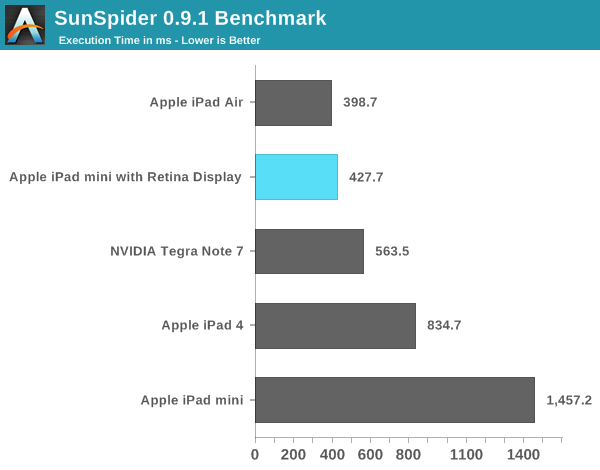

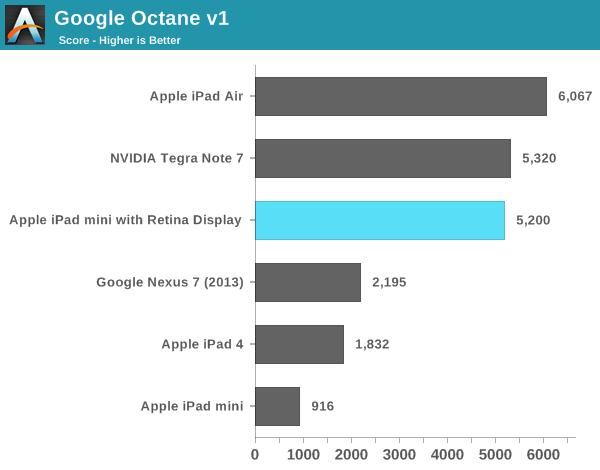
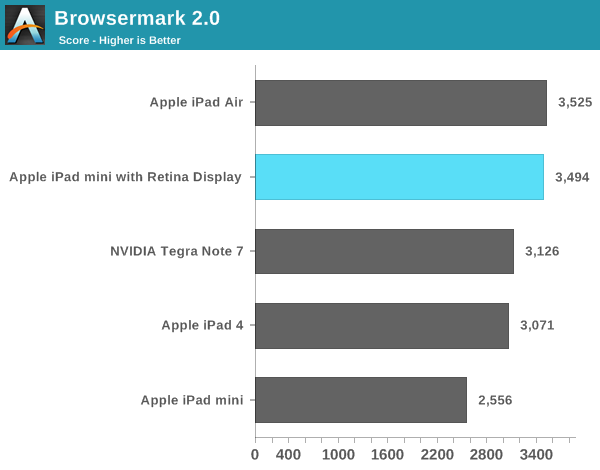
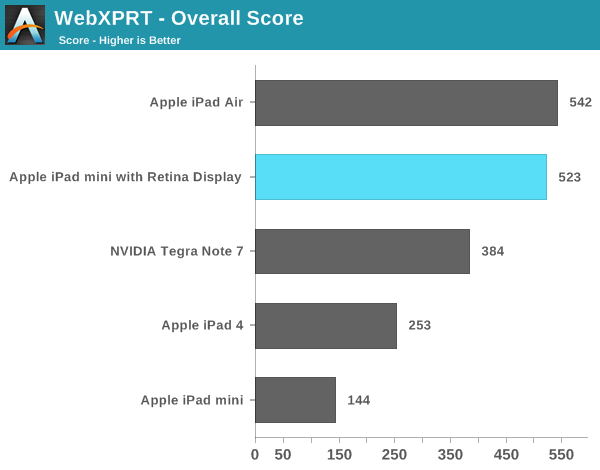
Compared to the first generation iPad mini, the new model is in a completely different performance league. Keep in mind the first mini used Apple’s A5 SoC based on an ARM Cortex A9. That’s the same single threaded performance as what’s in an iPhone 4S, and under iOS 7 it’s clearly running into some performance limits. The new mini with Retina Display however is a completely different animal. It’s fast.
Even comparing to the 4th generation iPad, the new mini is noticeably quicker.
Memory Bandwidth
Looking at the iPad mini’s memory bandwidth curve, we see it tracks very closely with that of the iPhone 5S. This is a slightly modified version of our previous bandwidth test, and you can see peak usable memory bandwidth (from the CPU’s perspective) of around 10GB/s. The ~12GB/s area right before you get out to main memory is bandwidth to the A7’s 4MB system-wide cache that sits after the shared L2 and the memory controller. This cache appears to service CPU, GPU and ISP requests at least.
GPU Performance
I believe the A7’s PowerVR G6430 GPU runs at around 450MHz. This frequency appears unchanged across all three A7 implementations. Once again, the big difference is how much thermal headroom exists in the platform which has an impact on overall performance.
Kishonti’s low level GPU performance tests back up my assertion that GPU frequency is fixed across all A7s. The iPad mini with Retina Display delivers equal performance to the iPad Air. The bigger news here is that nearly all of the GPU bound 3D tests seems to peg the mini and Air as equals. These are some pretty intense tests, but it looks like on the GPU side there’s no significant throttling when running at full tilt.
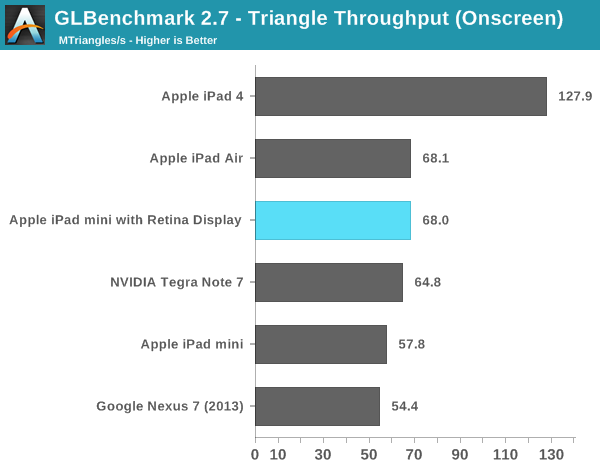

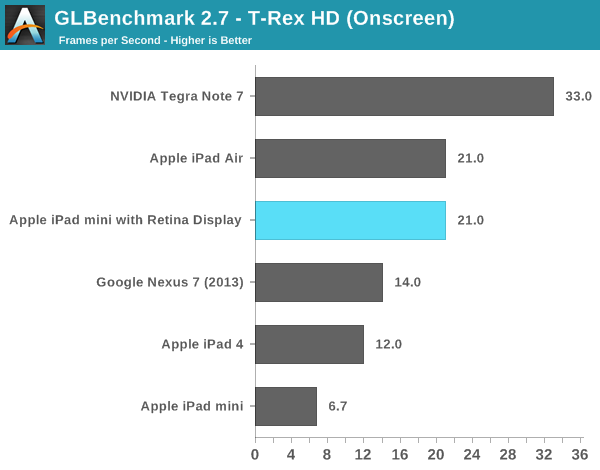

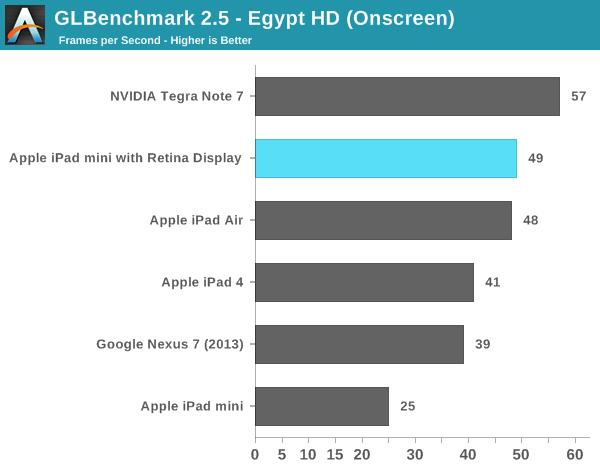
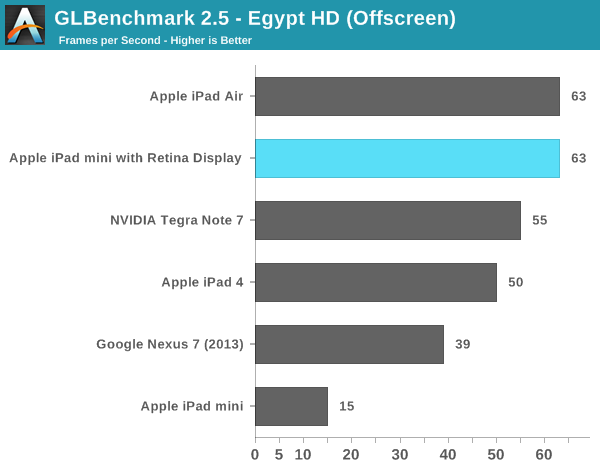
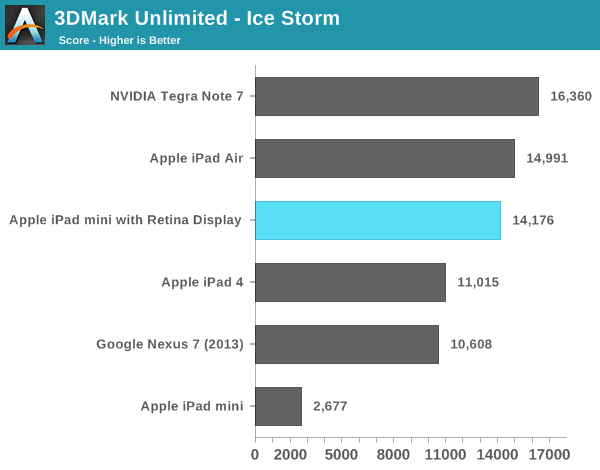
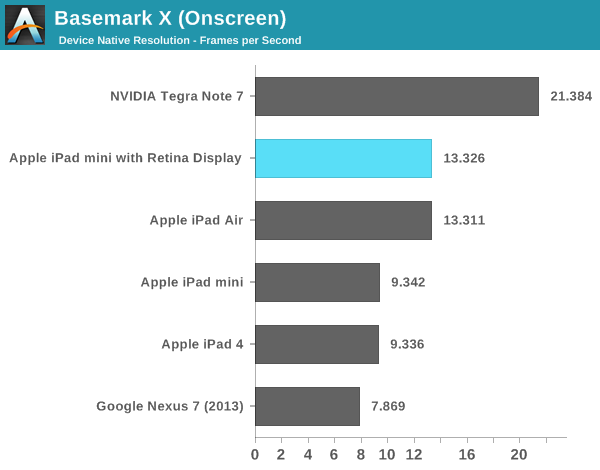
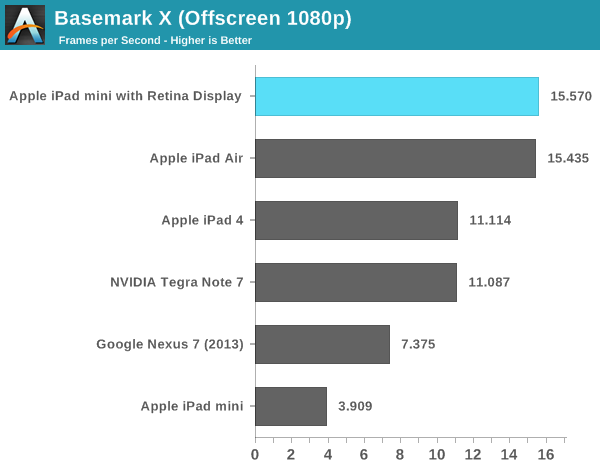
As I mentioned in our iPad Air review, despite having less peak theoretical memory bandwidth than the A5X/A6X, the A7 in the iPad mini never seems to regress in performance compared to even the iPad 4. Across the board the mini appears to be faster, more responsive and have more performance on tap than any prior iPad (big or small). The comparison to the original iPad mini is of course night and day. Even looking at lighter tests like the old GLBench Egypt HD benchmark, the iPad mini with Retina Display manages to be nearly twice as fast as the original mini - all while rendering 4x the number of pixels.


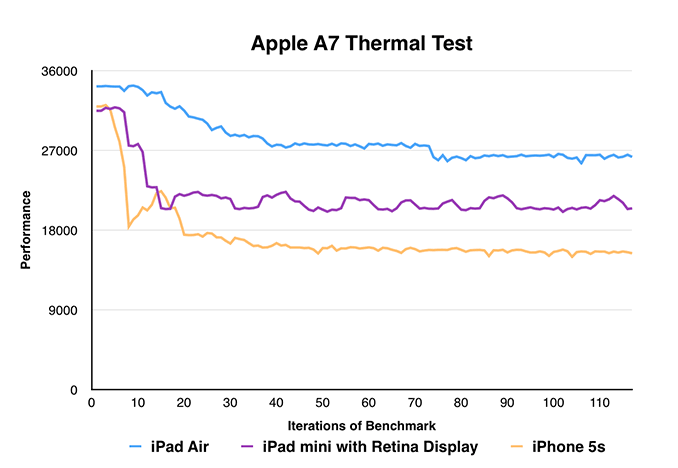
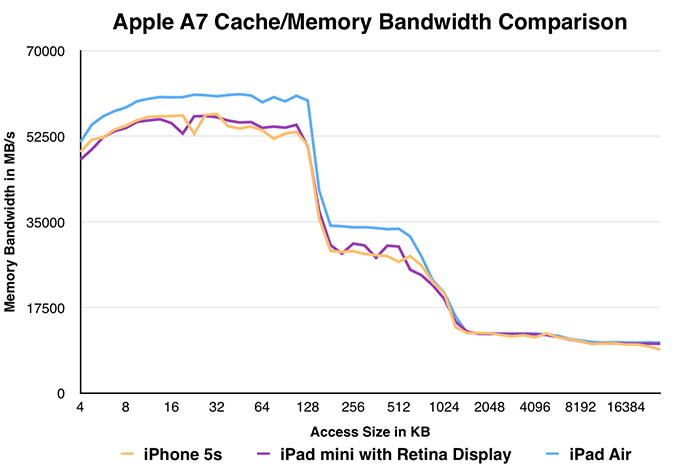








345 Comments
View All Comments
rake36 - Tuesday, November 19, 2013 - link
It costs less than half as much. Currently $239 for 32GB version...Walkop - Wednesday, November 27, 2013 - link
I'd like to comment that the Nexus 7 2013's power consumption on the display is incredibly low even at maximum brightness (which is extremely high, overall).1.7 watts. That's literally HALF the power consumption of the Retina Mini at max brightness, which is 32% dimmer than the Nexus 7. That alone is a massive gain; you should be able to use the Nexus 7 at maximum brightness much longer than the Mini. Not that this is a normal use case, but it IS good to know.
See here: http://www.displaymate.com/Tablet_ShootOut_4.htm
tigmd99 - Saturday, November 16, 2013 - link
Did you not read his last paragraph? Or are you just a blind Android fanboy?BPB - Saturday, November 16, 2013 - link
Yes, read it. No, not at all.I had to leave AT&T for work reasons so I had to give up my 920, which I loved. Have an HTC One and like it, but don't love it. I think too many Android apps are wanting, and I know in many cases the iOS version is better. My point is that this site's love for Apple knows no bounds. As soon as its founder switched it was all over, Apple could do no wrong. Yes, this is a nice device, no doubt. But the Nexus 7 is nice, and it's close to half the price. What does it take to simply admit that the 7 is probably the better buy for a person making a first time purchase? You pay 57% of what the mini costs! That's some deal in my mind, and yet I have no intention of buying either. I will probably get my daughter a Windows 8.1 tablet with good pen support so she can use OneNote, she is in college. My brother's family is all iOS, so I get them Apple related gifts. They're all good and have their strengths. But here, at this site, Apple is treated differently. If you don't think so just ask WP users.
tigmd99 - Saturday, November 16, 2013 - link
Why must he address every possibility or buying option? He stated that N7 is a very good alternative and cheaper. What do you want him to say? That it is superior in every way to iPad Mini? That would be stupid, no?A7 is far superior to Nexus 7 processor...far superior. App store, customer service, HD movies, etc. are better in iOS. (I have both at home, Note 2, Nexus 7 [2012], iPhones.) Do these things make up for the price difference? Well, only the end-user can determine that, which is kinda what Anandtech wrote.
Be fair.
Tetracycloide - Saturday, November 16, 2013 - link
Because addressing the single most competitive alternative is 'addressing every option.' Please...KPOM - Saturday, November 16, 2013 - link
My guess is that people considering an iPad mini aren't looking at Windows 8.1 devices. They are targeted more toward the iPad Air buyer. The Nexus 7 and Amazon Kindle HDX are the two devices most comparable to the iPad mini.kyuu - Saturday, November 16, 2013 - link
There are 8-inch Win8.1 tabs that are cheaper than the iPad Mini. Only reason someone wouldn't look at them is out of ignorance.abazigal - Saturday, November 16, 2013 - link
The reason I wouldn't consider windows tablets is simply because they don't meet my needs at all.Why would I want a 16:9 tablet running a desktop OS with apps still sporting a desktop UI?
sirfergy - Sunday, November 17, 2013 - link
The Dell is 16:10, <$299 and amazing. Full PC plus excellent touch experience.